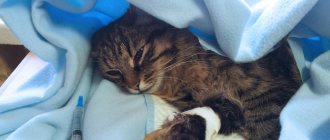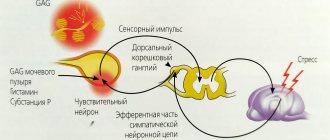From all over the vast expanses of Russia, and not only, I am often asked questions about the care, feeding and even treatment of cats, and this is quite natural, I am a veterinarian. They ask questions about nutrition, skin and hair problems, and especially often about problems of the genitourinary system. Experienced cat owners know that cats and especially male cats suffer from kidney disease. Kidney diseases are a difficult topic, requiring a lot of time, knowledge and experience in their study, prevention, diagnosis, treatment and recognition. The kidneys and skin belong to the excretory system of the body, like the liver, like the lungs, etc.
Their physiological functions are closely related. When the kidneys fail, the skin begins to partially perform its function of removing toxins. There is a certain concept of “uremic itching”. Itching occurs when there is an increased level of urea in the blood serum and an increased level of urea in the skin. In some cats with renal failure, itching may be associated with secondary hyperparathyroidism, leading to increased plasma histamine levels, impaired metabolism of calcium, magnesium and phosphorus, the cause of itching may be the accumulation of proteases or kinins, sometimes even the skin itself. covered with a thin coating of urea crystals.... Toxins that come out through the skin create conditions for the release of serotonin, which in turn irritates the nerve mediators of the skin and the cat begins to itch.
As I already stated in another article, itching in cats is not always an allergy to parasites, a true allergy or a food allergy. Pruritic dermatosis m.b. associated with diseases of the urinary system.
Cat owners and experienced breeders are able to distinguish diseases in the early stages, but many patients go to the doctor with a cat, and especially with seals, when the disease continues, when it is necessary to carry out expensive research, prescribe medications... i.e. when the disease is often advanced. I recommend that cat owners monitor the health of their pets themselves. It is not difficult, but the severe consequences of kidney failure can be prevented. Do a preliminary test of your cat's health by assessing the color of its urine. We all know that our cats go to the toilet with litter.
Renal coma in cats and dogs: causes, diagnosis, treatment
You need to empty all the filler from the tray. Wash the tray well and dry. Place a white sheet of A-4 paper at the bottom and, so as not to spoil the usual stereotype of a cat, pour a handful of filler into the corner of the tray. When the cat goes to the toilet, evaluate the color of the urine on a white sheet. Normal urine is any lemon color, i.e. from yellow to deep yellow. Any deviation in the color of urine - from pale yellow to colorless or greenish-brownish-pinkish and other non-characteristic colors should cause alarm. Already at this stage of the onset of the disease, you can improve your health, change the food to dietary, drink grass...etc.
Get tested at our veterinary clinic
DISEASES OF THE EXCRETORY SYSTEM IN DOGS
The volume of urine (single or daily), color, transparency or turbidity is determined, and the specific gravity is measured. Diseases, diet, and medications can change these indicators. Any dog owner may notice a change in the amount or color of urine; this may be the first symptom of the disease. It is recommended, however, to remember that some foods (for example, beets) can change the color of urine.
One of the most important characteristics of urine is its specific gravity. Changes in specific gravity values indicate a violation of one of the main functions of the kidneys, which is to maintain the water-salt balance of the body. A decrease in the specific gravity of urine is observed in renal failure. Urine specific gravity values are important for interpreting chemical and sediment results. Biochemical urine analysis, which is often used in veterinary practice, includes determination of urine acidity (pH), protein, glucose, ketone bodies, bilirubin and blood in the urine. All these indicators change under pathological conditions and are taken into account when diagnosing kidney disease. If there is doubt about the diagnosis, the urine test should be repeated two or three times within 7–10 days and take into account the average values of the indicators or their change (increase or decrease in values). An indicator of the condition of the kidneys and urinary organs is urine sediment. The urine sediment includes blood elements (erythrocytes, leukocytes), epithelial cells, casts and crystals. The crystalline precipitate consists of salts of inorganic elements. An increased number of crystals is formed, for example, with urolithiasis. There are salts of inorganic elements that are formed in acidic and alkaline environments. Normally, the pH of a dog’s urine is about 5–6; in an acidic environment (pH<5), oxalates are formed; in an alkaline environment (pH>7), struvite (phosphates) are formed. Among the many kidney diseases in dogs, several main ones can be identified: nephritis, nephrosis, urolithiasis and cystitis. Nephritis is an inflammation of the kidneys caused by an infection or allergy. The acute form of the disease develops after exposure to viral and bacterial diseases (leptosis is especially dangerous in this regard). In severe kidney diseases, urination is painful, the dog “hunches his back” - involuntary urination - observed in diseases of the urinary tract or disruption of the innervation of the excretory organs (this leads to relaxation of the sphincter, which does not allow urine to flow freely) - change in the color of urine: light, almost transparent - urine occurs when its excretion increases: bright yellow urine - liver disease; dark brown urine - with infectious kidney diseases (with admixtures of pus and blood), urolithiasis - swelling of the subcutaneous tissue in the area of the chest, lower abdomen, limbs. “Renal” edema has a soft consistency; when you press on it, a depression is formed; they are most noticeable in the morning. Edema can be not only external, but also internal, for example, pulmonary edema, which is accompanied by symptoms of bronchitis and shortness of breath. With nephrosis, edema is more pronounced than with nephritis - one of the inherent signs of kidney disease is uremia - self-poisoning of the body with urine components. Uremia includes the following symptoms: increased thirst and urination, depression, lack of appetite, exhaustion, vomiting. Sometimes ulcers appear on the mucous membranes. Another inherent syndrome is azotemia, which occurs due to increased concentrations of urea and other toxic nitrogen compounds in the blood. Azotemia is often not accompanied by clinical symptoms and is diagnosed according to a biochemical blood test. —
In case of kidney diseases, urine analysis is of great diagnostic importance, since urine is a product of renal activity and changes in its physical and chemical parameters immediately reflect a dysfunction of this organ. Urinalysis begins with a visual and physical assessment. The urinary system includes the following organs: kidneys, bladder, ureters and urethra. The main organ is the kidney, which maintains water-salt balance in the body and removes metabolic products. Kidney and urinary tract diseases are quite common in dogs. diseases develop unnoticed over many years and appear with age. The most common cause is improper feeding: dogs’ kidneys are designed in such a way as to remove large amounts of protein byproducts from the body, due to which dogs’ urine is normally acidic (pH 5.0–6.5). With prolonged feeding of foods containing a lot of carbohydrates, for example, cereals, the acidity of the urine changes. If acidic urine prevents the development of infection, then alkaline urine, on the contrary, is favorable for microorganisms. Slowly developing chronic infections gradually affect the entire kidney and can spread to other internal organs. Damage to the kidneys with impairment of their function leads to the development of intoxication and severe self-poisoning of the body. Kidney diseases (nephritis, nephrosis) are more common in dogs than urinary tract diseases (cystitis, urocystitis). Urolithiasis in dogs is not observed as often as, say, in cats, and usually develops after the fourth year of life. The following symptoms may indicate a disease of the excretory system: . - excessive thirst and increased amount of urine - may be the first signs of insufficient kidney function. When the kidneys fail to cleanse the body of many metabolic products, harmful substances begin to accumulate in the blood and other organs. Intoxication of the body develops, which is accompanied by loss of weight and appetite, vomiting, weakness, etc. Increased thirst and increased amount of urine can be symptoms of diabetes mellitus or diabetes insipidus. It is very important to establish a diagnosis as early as possible, then with the help of treatment and support for the general condition, you can prolong the dog’s life - difficulty urinating or frequent urination of small amounts of urine (or no urine at all) - this happens with inflammatory processes in the bladder, ureters and urethra or with urolithiasis diseases. When palpating the dog's abdomen, you may notice that the bladder is enlarged and tense. The dog has a frequent urge to urinate, little urine is released, and its color has changed. Obstruction of the ureters (for example, due to blockage by stones) can be suspected if urine does not pass through or is released drop by drop when pushing. If there is no urination for a long time, toxic substances begin to be absorbed from the urine into the blood - poisoning of the body occurs. Intoxication can develop very quickly, accompanied by vomiting, depression, and in some cases, fever. Chronic nephritis often results from acute nephritis or chronic infection. In acute nephritis, the external tissues of the kidneys are mainly affected, and in chronic nephritis, the internal ones (capillaries) are affected. Sometimes there is extensive tissue inflammation - acute and chronic pyelonephritis. Differential diagnosis of nephritis is presented in the table.
| Disease | Clinical symptoms | Laboratory data |
| Acute nephritis (glomerulo-nephritis) | Frequent urge to urinate when the total amount of urine decreases. Increased body temperature, severe vomiting, palpation of the kidneys - pain, temporary paresis of the hind limbs may be observed. | The color of urine is red-brown (“the color of meat wash”), the reaction is acidic, and the specific gravity is increased. Urine contains many formed elements of blood, casts, etc. When examining blood, elevated ESR, leukocyte count, urea, and sometimes creatinine are detected. X-ray shows enlarged kidneys |
| Chronic nephritis | Intense thirst and increased urine output with significant dehydration. Visible mucous membranes are pale, with a grayish tint. Swelling, signs of bronchitis and gastroenteritis may develop. With prolonged poisoning of the body, nervous phenomena (uremia) develop. | The urine is dark, the specific gravity is normal or low, the amount of protein and leukocytes is increased. Biochemical blood parameters - protein, leukocytes, creatinine can be either increased or decreased. The kidneys are reduced in size. |
| Acute pyelonephritis | Urinary incontinence, but urination is painful, the characteristic posture is an arched back. Fever, rapid breathing, vomiting. Often accompanied by an infectious disease of the genital organs. No swelling is observed. | Pyogenic microorganisms or sand are found in the urine. The urine is cloudy, may have an alkaline reaction (sometimes an “ammonia” smell), and the specific gravity is low. |
| Chronic pyelonephritis | There are no painful manifestations or pronounced symptoms; often the diagnosis can be established only by urine analysis and x-ray. | Contrast pyelography is performed - in the picture the size of the kidney is increased, the internal structure has a deformed pattern. |
Treatment of nephritis is aimed primarily at eliminating the infection. Antibiotics are prescribed (preferably cephalosporins), but they cannot always be used. Nitrofurans (furadonin, furatsilin), prednisolone (1 ml, IM, once a day for 5–7 days), baralgin (2–3 ml, IM, 1–2 times a day), aminophylline must be prescribed (1 ml, IM or IV, 1–2 times a day). If necessary, intravenous infusions of saline solutions with the addition of mannitol and reoglu- are prescribed. mana Nephrosis is a disease in which kidney tissue changes. The epithelium of the renal tubules and glomeruli, where urine formation occurs, is mainly affected. Nephrosis is characterized by the so-called nephrotic syndrome: an increase in the amount of protein in the urine with a reduced content in the blood serum and persistent edema. Nephrosis, as a rule, develops secondarily as complications of other diseases and occurs quite often in dogs. With some infections (for example, plague) and poisoning, concomitant nephrosis may develop, which is not a serious disease. In mild forms, nephrosis can be determined only by analyzing urine and blood: the specific gravity of urine is low, the urine is light, its quantity is higher than normal, and blood cells are found in the urinary sediment. In severe forms of nephrosis, symptoms of renal failure are observed - uremia, vomiting, diarrhea, heart sounds become weak and muffled, edema develops (of the eyelids, dewlap, extremities). If the underlying disease can be determined to cause kidney damage, special treatment is prescribed. Antibiotics, sulfonamides, and nitrofurans are used against infectious agents. The best combination for the treatment of kidney infections is erythromycin and furadonin (1 tablet of each drug 3 times a day). Nephrosis cannot be completely cured, so treatment is aimed at eliminating the symptoms: to relieve swelling, triampur or intravenous infusions of mannitol solution are prescribed. To normalize protein metabolism, retabolil is administered. Most of these diseases end in chronic kidney damage and are not completely cured. Prescribing special treatment will prolong the dog's life and, possibly, stop the painful process. If the cause of a chronic disease is established, specific treatment is prescribed. In any case, supportive treatment of a dog with chronic kidney disease includes the following measures: providing free access to clean water (if there is no edema), prescribing medications that normalize the acid-base and salt balance of the body - sodium bicarbonate, calcium, drugs that bind phosphorus in the intestines, if necessary, anticonvulsants and medications that lower blood pressure. In chronic renal failure, the most important component of treatment is a properly selected diet. Special nutrition can help smooth clinical signs and slow the progression of kidney disease. The goals of nutritional therapy can be defined as follows: meeting the nutritional and energy needs of sick animals, eliminating clinical signs of uremia, if present, eliminating disorders of vitamin and mineral metabolism, and attempting to slow the progression of renal failure. To do this, dietary rations must contain a standardized amount of proteins, fats, vitamins and microelements (phosphorus, potassium, sodium calcium). Urolithiasis is more common in breeds such as dachshunds, miniature poodles and pinschers, spaniels and others. These dog breeds are more likely than others to have disturbances in phosphorus-calcium metabolism in the body and diseases of the thyroid gland. Urolithiasis can also be asymptomatic and detected only by examining urinary sediment (increased number of crystals). With urinary tract infections or impaired water-salt metabolism, stones can increase in size and clog the urinary tract (usually the urethra of male dogs, since the urethra is wide). Sometimes there is only one symptom: frequent urge to urinate, which happens with nephritis or cystitis. However, specific treatment for these diseases does not provide improvement.
Uremic syndrome in cats
Uremic syndrome (uremia) is a complex of symptoms and changes in biochemical parameters characteristic of all animals with severe renal failure.
Signs of uremia include depression, lethargy, weakness, reluctance in the cat to socialize, and weight loss; as well as decreased or lack of appetite, vomiting and unpleasant odor from the mouth.
Laboratory tests reveal increased levels of urea and creatinine in the blood serum, increased phosphorus concentrations, decreased potassium, acid-base imbalance, and anemia. Also, uremic syndrome is usually accompanied by a persistent increase in systemic blood pressure.
To reduce the manifestation of uremia, it is necessary to prescribe a diet low in protein and phosphorus. Additionally, it is necessary to add substances to the feed that bind phosphorus in the intestines.
With the development of secondary (renal) hyperfunction of the parathyroid gland, sometimes, in addition to monitoring phosphorus intake, calcitriol is prescribed (which, in the event of renal failure, is no longer produced by the kidneys in the required quantity). The administration of calcitriol requires increased control of blood calcium levels in cats.
Vomiting is present in almost all cats with uremia. To reduce nausea and vomiting, drugs are prescribed that protect the mucous membrane of the gastrointestinal tract, and sometimes additionally also centrally acting antiemetic drugs.
Most cats with chronic renal failure have decreased blood potassium concentrations. Such animals are prescribed supplements containing potassium citrate or gluconate. Excess potassium usually occurs only in the terminal stage of renal failure, when urine production has practically ceased.
Insufficient kidney function often leads to a shift in the acid-base balance in the blood to the acidic side - the development of metabolic acidosis. Therefore, in case of uremia, sodium bicarbonate or potassium citrate is added to the feed.
To maintain water and electrolyte balance, subcutaneous injections of complete electrolyte solutions (for example, Ringer's solution) are prescribed.
Healthy kidneys produce erythropoietin, a substance that stimulates the formation of red blood cells. In chronic renal failure, insufficient erythropoietin is produced, which leads to the development of anemia. Cats with clinical signs of anemia are treated with human recombinant erythropoietin. But, unfortunately, many cats quickly develop antibodies to it, which makes its use pointless.
High blood pressure is another complication of chronic renal failure. Severe arterial hypertension is extremely harmful. Typically, ACE inhibitors, calcium channel blockers, and a low-sodium diet are prescribed to control high blood pressure. It is necessary to monitor blood pressure regularly throughout the selection of drug dosages, and in the future at least once every 3-6 months.
Cats with uremia should be seen regularly by a veterinarian to have their prescriptions adjusted. Most medications must be taken for life.
Chronic renal failure in cats
The most effective treatment for urolithiasis is possible at an early stage. If salt crystals are detected in urine sediment, drugs are prescribed that dissolve them. The diet also depends on the type of stones: if phosphates are detected, a diet containing cottage cheese and meat is prescribed; if oxalates are present, on the contrary, meat is limited and more raw vegetables are given. If the stones are large and block the urethra, treatment is aimed at restoring the patency of the urinary tract. When the bladder is full, urine is released through a catheter, the bladder is washed and antispasmodics (baralgin) are prescribed. If necessary, surgery is performed - opening the urethra or bladder to remove stones. Cystitis is an acute or chronic inflammation of the bladder, sometimes accompanied by inflammation of the urinary tract (urocystitis). This leads to bladder overflow, urinary retention and self-poisoning of the body. A blockage of the urethra can manifest itself as painful attacks (a hunched back, sudden weakness and paresis of the hind limbs). For symptoms of uremia, the amount of protein is limited. If a large amount of protein is excreted in the urine (and swelling is observed), on the contrary, diets rich in protein are prescribed. It is preferable to use ready-made diets from “Pedigri” and others, “Purina”) with a low content of phosphorus and protein for uremia or with an average content of protein and low phosphorus. When preparing a “homemade” diet, add no more than 6% protein (or approximately 1.9 g/kg body weight per day, for uremia - even less, 1 g/kg), do not give table salt, add subgroup B vitamins (for example, dry yeast) and an increased amount of fat - 15–20% (for example, vegetable oil), it does not harm the dog’s health and adds calories and taste to the food. In any case, the diet should be prescribed by the attending veterinarian. Urolithiasis is the formation of urinary stones in the kidneys or bladder. Large stones can block the ureters or urethra. More often it occurs as a complication of kidney disease or urolithiasis. Cystitis is differentiated from pyelonephritis (with pyelonephritis, pain in the kidney area) and urolithiasis (the presence of crystals in the urinary sediment). Therefore, the main cause is infection. The main symptom, which is sometimes the only one, is frequent painful urination. Urine may be clear, but more often it is cloudy, sometimes mixed with mucus and pus. In severe cases of the disease, there is an increase in body temperature, vomiting, and depression. Upon palpation through the abdominal wall, a dense and painful bladder is detected. An increased content of protein, blood cells, and sometimes microorganisms are found in the urine. To suppress infection in cystitis, antibiotics (biseptol), sulfonamides (urosulfan), and furadonin are prescribed. It is possible to rinse the bladder through a catheter with antiseptic solutions (furacilin), 0.5% collargol solution, etc. Diet and treatment depend on the acidity of the urine. If the urine pH is acidic, urotropine or horsetail decoction is prescribed and the amount of protein in the diet is reduced; if the reaction is alkaline, bearberry decoction is prescribed and more meat, cottage cheese and other protein products are given. Feeding can be normal, but you should not give your dog spicy and salty foods (sausage, salted fish, fried food). .
Home Back Forward
Information obtained from open sources. When using materials from this site, a link is required.
Articles are copyright holders.
Renal failure in cats, acute renal failure and chronic renal failure, causes and treatment
Treatment for acute renal failure in cats should begin only after the diagnosis has been confirmed by a veterinarian. Only a veterinarian prescribes a regimen and decides how to treat the cat. Not the owner, but a qualified specialist. Any mistake or delay can lead to the death of your pet.
All therapy is aimed at restoring kidney function. Therefore, the doctor decides which medications are needed first. Most often, antibiotics are prescribed (they do not allow bacteria to multiply and spread through the bloodstream throughout the body), droppers with glucose or sodium chloride (to eliminate dehydration and restore water-salt balance), drugs that support cardiac activity, vitamins (ideal A, D, E ). But dialysis is crucial in therapy - cleansing the blood of toxic substances.
Hormones may be prescribed (for example, dexamethasone, prednisolone). Prednisolone helps restore water-salt balance, but only after stabilization of the general condition.
Furosemide will help cleanse the kidneys, as urine is excreted. Lactose helps remove feces (due to dehydration, they become dry, hard), and toxins accumulate in the intestines. If lactose does not help, then an enema may help. But at the same time as giving diuretics and laxatives, droppers must be placed, otherwise the animal will suffer from dehydration.
Basic provisions
Treatment of chronic renal failure
Uremic syndrome
Anemia
Treatment of acute renal failure
Power supply during emergency
What's going on?
Reasons Mon
When the diagnosis of kidney failure in cats is accurately established, treatment is prescribed in accordance with the type of disease. Acute and chronic failure require different approaches. In each specific case, individual therapy is prescribed.
In case of acute deficiency it is important:
- remove toxins from the blood;
- prevent anemia;
- eliminate side symptoms (vomiting, diarrhea, high blood pressure);
- normalize blood pressure.
To solve these problems, the veterinarian will prescribe medications, draw up a medication schedule and calculate the dosage based on the weight and age of the animal.
Therapy is effective when started on time and the cause of the disease is identified. If the cause of renal failure is difficult to identify, then there is a possibility that the disease will recur many times and after some time will develop into chronic failure.
For chronic renal failure, therapy should be lifelong. It is impossible to stop this type of disease, and the goal of the measures is to ensure that the cat lives as long as possible. A set of measures is aimed at slowing down the process of death of organ cells, eliminating symptoms, normalizing metabolism and improving the general condition of the animal.
Treatment for chronic renal failure may be more or less intense, depending on the stage of the disease and the severity of symptoms.
When postrenal or prerenal causes are identified, they must be eliminated or the harm they cause must be minimized. We will not consider them here.
The main method of treating chronic renal failure is intravenous infusions (droppers). In cases where there is significant dehydration, lack of appetite and thirst, there is no way to do without them.
At the same time as introducing a significant amount of fluid into the patient's blood, the doctor must ensure that the animal has adequate diuresis (urine production by the kidneys). Otherwise, pulmonary edema may develop and the cat will die.
Owners of cats with chronic renal failure have to expend considerable effort on treating their animal, because traveling to the clinic, even if it is located close to home, 2 times a day for IV drips is quite difficult. You need to be prepared for this.
The dropper consists of salt solutions that replenish the deficiency of fluid and electrolytes in the body, as well as drugs that improve kidney perfusion, increase diuresis, antibiotics (if necessary), and antihypoxants.
In addition, medications that lower blood pressure and have a nephroprotective effect are used as needed - slow calcium channel blockers and ACE inhibitors (Angiotensin Converting Enzyme). These drugs dilate renal vessels and improve renal blood flow, increasing the glomerular filtration rate. However, these medications should be used under the supervision of a physician, with constant monitoring of blood pressure and heart function.
DETAILS: Acute and chronic renal failure in cats
In some cases, animals with chronic renal failure require parenteral nutrition (via a dropper) or tube feeding.
Our clinic operates a hospital where animals with chronic renal failure undergo all the necessary procedures and are provided with round-the-clock supervision by a veterinarian.
The advantages of inpatient treatment are:
- the ability to carry out round-the-clock infusions with a low rate of infusion of solutions using syringe dispensers and, as a result, increasing the effectiveness of treatment;
- 24-hour medical supervision;
- regular blood pressure measurement;
- additional procedures if necessary: placing a nasoesophageal tube and enteral feeding, taking blood and performing repeated tests, etc.;
- no need for animal owners to spend significant time and effort on treating their pets.
If the diagnosis of renal failure is confirmed, then therapy is prescribed by a veterinarian in accordance with the stage of the disease. If the disease manifests itself in an acute form, then treatment should occur immediately. Since acute renal failure is caused by any type of blockage of the urinary tract, the obstruction of the canals must be urgently eliminated. At an early stage, the course of the disease is reversible, and if the appropriate set of measures is taken, the cat can live a long and fulfilling life.
In the first stages of the disease, the owner of the animal should not self-treat the cat and give it drugs with a dubious spectrum of action. A veterinarian will prescribe competent therapy. Therapy may consist of prescribing intravenous solutions that will correct the imbalance of substances in the blood and help stabilize the pet’s condition. When diagnosing chronic renal failure - chronic kidney disease in cats, treatment by stages should be carried out under the supervision of a veterinarian.
The disease at this stage is incurable and affects mainly adult and elderly cats. The diagnosis of chronic renal failure is made by a veterinarian if more than 70% of the kidney tissue is damaged or scarred.
To eliminate the symptoms and reduce the cat’s suffering in such cases, veterinarians prescribe a complex of palliative treatment. Drug treatment for chronic kidney disease in cats may consist of the following measures:
- The pet's diet includes medicinal food for cats for kidney failure from a good manufacturer.
- Infusion therapy is prescribed.
- Conservative treatment methods are used that do not stop, but slow down the degradation of the kidneys.
In severe cases, therapy involves surgical removal of the non-functioning kidney, but this decision is made by the veterinarian after tests confirm that a pet with one kidney can live a full life. Also, if chronic kidney disease is diagnosed in cats, a kidney transplant may be performed.
After the veterinarian has determined the cause of the disease, studied the medical history and assessed the general physical condition of the cat, he may prescribe the use of a number of medications. Therapy is prescribed on an individual basis, since all animals have their own body characteristics and need certain medications and appropriate dosages.
Basically, the following types of veterinary drugs are used to treat the disease:
- intravenous drips to remove toxins from the blood;
- drugs to increase urine production;
- medications to control anemia;
- medications to eliminate electrolyte disturbances;
- medications for high blood pressure, vomiting and gastrointestinal disorders.
Prednisolone for cats, a catabolic drug with immunosuppressive properties, may sometimes be prescribed. To treat metabolic disorders, your pet may be prescribed Ketosteril for cats, which must be taken in accordance with the instructions. This drug contains artificial analogues of essential amino acids and helps in the fight against chronic renal failure.
In addition to the veterinary medications listed above, Ipaketin for cats can be used in the treatment of chronic renal failure, which can be purchased at a veterinary pharmacy. The drug Ipaketine for cats, the price of which is about 300 rubles per 50 grams, is a nutraceutical drug. It improves the functional state of the kidneys and allows for long-term remission.
Pet diet
In order for a cat with kidney failure to have the right to a full life, its diet must be properly balanced. Sick cats are recommended to eat a diet low in phosphorus and protein. These products put a lot of strain on the excretory organs and can cause further deterioration of the pet’s condition.
The small amount of protein included in a cat's diet to support his muscles and tissues must be extracted from quality foods. Optimal sources of lean protein include egg whites, liver, and chicken and turkey fillets. The diet of a pet struggling with illness should include an optimal balance of vitamin D and omega-3 fatty acids.
In addition to natural food, the owner can use ready-made food in the cat’s diet. There are currently many commercial brands on the market working on creating veterinary food lines. Among them, the owner can choose food for cats with kidney failure, which has a special low-fat recipe.
Causes of renal coma
The immediate cause of renal coma is acute or chronic renal failure. With this pathology, a person’s kidneys begin to filter urine poorly and because of this, all pathological metabolic products are not removed from the blood, but continue to circulate in it. Urea and creatinine, which are these very pathological products, when they enter the brain, lead to a disorder of thinking and consciousness, and if they stay there for a long time, they even cause a loss of consciousness with a partial disorder of blood circulation and breathing.
But renal failure is the immediate cause of coma. There can be many reasons for kidney failure itself. The most common pathological processes that lead to a disorder of consciousness of renal origin are chronic kidney diseases. Conditions such as pyelonephritis and glomerulonephritis, characterized by inflammation of the kidney tissue, can cause impairment of kidney function and lead to the accumulation of kidney waste products in the human blood.
In addition, the problem may be hidden somewhat lower when the outflow of urine is disrupted due to a bladder stone or prostate adenoma.
What is it, the mechanism of development of pathology
Actually, coma is the “vegetable” state of an animal, in which only the general functional systems of the body work. That is, the “carcass” breathes, defecates and urinates, but the pet remains in “anabiosis.” In this case, a similar result is caused by the accumulation of nitrogenous bases in the blood, including urea. The main reason is kidney failure . Therefore, consideration of pathology should begin with its development, predisposing factors and symptoms.
Kidney failure is defined as the inability of the kidneys to remove waste products from the blood. The accumulation of toxins leads to the development of symptoms of uremic poisoning, which, in turn, leads to renal coma.
It can appear either suddenly (acute renal failure), as a result of poisoning, or gradually (chronic form of the disease). The latter type is more typical for many infectious diseases and chronic poisonings.
The main sign of kidney problems is increased frequency of urination and sharply increased thirst. Moreover, in some cases, sick dogs and cats may spontaneously urinate while walking. These signs indicate extremely serious problems with the kidneys, which are unable to concentrate and store urine. Control over the process of urination weakens, the urinary system practically stops working normally.
All the ammonia, nitrogenous bases, acids and other chemical “waste” accumulate in the tissues and blood. This is called uremia. The degree of uremia is determined by measuring blood urea nitrogen (BUN), creatinine and electrolytes. The higher they are, the closer the animals are to renal coma.
Chronic renal failure in cats and kittens: symptoms and treatment
In this case, stagnation of urine, first in the bladder, and then in the kidneys, leads to the destruction of membranes in the renal tubules, which ends with the direct release of urine into the bloodstream. Such situations are quite rare, because before urine stagnation in the kidneys begins, the patient will be bothered by acute pain in the pubic area, with which he will definitely come to the doctor.
But when the blockage occurs slightly higher, at the level of urine outflow from the kidney, then a similar situation is quite real. Most often, the cause of such stagnation is a stone, although there are cases of blockage at this level by a tumor. Clinically, this is manifested by renal colic, which slowly turns into uremia.
Also, the cause of renal coma can be a variety of poisonings that lead to impaired renal function. The group of kidney poisons includes benzenes, lead and others.
Uremia symptoms
Symptoms of the disease appear gradually along with an increase in intoxication. A large volume of light-colored urine indicates a disturbance in the functioning of the kidneys. Gradually, urine is excreted in ever smaller quantities, and metabolic products accumulate in the body.
For weeks or even months, a precomatose state is observed, which can result in coma. The first signal will be a disturbance in the functioning of the gastrointestinal tract. Appetite decreases and soon the patient completely refuses food and drinks a lot of water. Urea accumulates in saliva, which leads to bitterness in the mouth and a characteristic smell of ammonia. Urea also accumulates in gastric juice, which leads to colitis and gastritis. Nausea, vomiting, and diarrhea mixed with blood appear.
Uremia leads to disorders of the central nervous system. A sick person develops weakness, apathy, rapid fatigue and stiffness in movement. Insomnia and gradual loss of consciousness begin. In uremic coma, noisy breathing and short exhalations are heard. Body temperature does not rise above 35°C, loss of vision is observed and anemia develops. Urea and waste lead to dry skin, trophic ulcers and itching.
Symptoms of renal coma
By definition, it becomes clear that renal coma must be manifested by a lack of consciousness.
True, it is necessary to remember that immediately before the coma itself there is a period of time when a person begins to “boot up” from a state of clear consciousness. During this period of time, so-called uremia , which is very important to diagnose in order to prevent the person from falling into a coma.
During uremia, the patient begins to be bothered by cerebral complaints. It is manifested by confusion, constant dizziness, a state of excitement or, conversely, depression. A random person without medical education, seeing such a patient, would say that he was simply delusional. In principle, this is how it is. The only thing that can indicate the presence of uremia in such a situation is the smell of urine from the mouth. As a rule, in such patients it is felt quite distinctly, so that you don’t even have to lean close to the patient to feel this smell.
Immediately after uremia, renal coma . Against the background of all the above complaints, the person begins to slowly lose consciousness. As a rule, most medical examinations of such patients occur precisely in a coma state. In such a state, it is very important to determine whether the person is alive and to find out the cause of this condition. The same smell of urine from the mouth, which only intensifies as the condition worsens, can help with the cause.
Evidence that a person is in a state of coma and not dead is the presence of spontaneous breathing, a pulse in the carotid and radial arteries, as well as the presence of reflexes from the cornea of the eye. The latter can be checked very easily by touching the open eye with some object. In case of coma, the patient will definitely react by constricting the pupil.
What to do?
If a cat has fallen into a coma, it is important for the owner to understand that in most situations the cat will die soon, so it is necessary to contact a veterinary clinic as soon as possible. It is impossible to help a pet at home. The veterinarian will do the required tests that will reveal what caused the coma. The research results will make it possible to prescribe the correct treatment. Depending on the factor that caused the problem, different medications are prescribed.
To maintain the vital functions of the body, the animal is prescribed the necessary medications.
In almost every situation, they resort to the help of medications that support cardiac activity and relieve the animal from intoxication of the body. In some situations, a cat may end up in a coma after surgery. In this case, as noted by veterinary doctors, antibacterial medications are also prescribed to prevent secondary infection.
Diagnosis of uremic coma
The entire list of diagnostic procedures during renal coma is aimed at determining the severity of the patient’s condition and finding out the immediate cause of the disease. To determine the severity of the patient, blood is taken from him to conduct a general blood test and measure the amount of urea and creatinine of the latter. The level of these two substances in a person's blood can guide doctors to the correct treatment.
Much more research may be needed to determine the root cause of the disease. The first step is an ultrasound of the kidneys and radiography of the pelvic organs. These two studies can help determine the presence of stones in the bladder or kidneys. In addition, ultrasound gives the doctor a clear picture of the condition of the kidney tissue. In more complex cases, a computed tomography scan of the abdominal cavity and pelvis can be performed.
Ultrasound of kidneys with stones
In addition, the level of electrolytes in a person’s blood is determined in order to control the amount of infusion therapy that will be given to the patient.
Diagnosis
The diagnosis is made on the basis of anamnesis, laboratory tests (blood and urine tests), visual diagnostic methods (ultrasound examination of the excretory system, x-ray examination). A biochemical blood test is necessary to determine the levels of creatinine, urea, ammonia, phosphorus, and electrolytes. A general blood test shows the presence of anemia, inflammation, etc.
Since uremia is not an independent disease, but represents general symptoms characteristic of various diseases affecting the excretory system, it is necessary to differentiate the diseases themselves and the causes that caused them.
Treatment of renal coma
Treatment of uremic coma can be divided into drug and hardware. As for the first, in this situation intravenous infusions of large amounts of fluid are performed. For this purpose, solutions of glucose or table salt are used, which in medical language are called saline solution. After a certain amount of liquid is injected into the vein to dilute the metabolic products present there, diuretics are used that help remove these same products from the body. For this purpose, powerful diuretics such as lasix or furosemide are used. In principle, these drugs can be bought independently at a pharmacy, but this makes no sense, since they are administered only into a vein and in a hospital setting.
Infusion therapy also includes drugs that prevent blood clotting. This group includes the well-known heparin; it is also administered subcutaneously in hospital treatment.
In the most severe cases, hormones are used. This group includes drugs such as prednisolone and dexamethasone.
As for hardware treatment, it can be used both to treat renal coma and to eliminate its root cause. For example, if a coma is caused by a stone or tumor, then in such a situation it is simply impossible to do without surgery. If the outflow of urine is obstructed by an enlarged prostate, then in such a situation it is necessary to insert a urethral catheter into the cavity of the bladder, which will instantly relieve the symptoms of acute urinary retention.
In a situation where it is not possible to conservatively remove all toxins from a person’s blood, it is necessary to use methods such as plasmapheresis or hemodialysis. In this case, the patient is connected to a special device, which, passing human blood through itself, cleanses it of various toxins and pathological metabolic products.
Hemodialysis machine
Treatment
Treatment is prescribed depending on the disease being diagnosed, as well as symptomatic care. An animal in serious condition must be hospitalized under round-the-clock supervision to ensure rest, intensive therapy, urinary monitoring, and cardiac and respiratory monitoring.
Treatment regimens for various diseases are generally similar. Below are some examples.
Acute renal failure:
- Restore diuresis. In the absence of this, placing a urethral catheter, or pumping urine out of the bladder with a syringe.
- Infusion therapy to restore water-salt balance.
- The use of drugs that restore microcirculation and blood flow in the kidneys, as well as diuretics.
- Symptomatic treatment.
- In severe cases of hemodialysis.
- The prognosis is most often unfavorable.
Chronic renal failure:
- Infusion therapy.
- To prevent the occurrence of edema, use diuretics. The use of drugs that improve renal perfusion, when blood pressure increases, calcium channel blockers, ACE inhibitors, antibiotics may be used to prevent the development of infection.
- Provide food for the animal.
- At a severe stage, hemodialysis.
- The prognosis ranges from cautious to unfavorable.
Urolithiasis disease:
- Depending on the nature of stone formation: conservative or surgical treatment.
- Conservative treatment: use of antispasmodics, antibiotics, novocaine blockades, pH stabilization, use of specialized feeds, restoration of urine outflow (including through bladder catheterization and lavage).
- Surgery: removal of stones if conservative treatment is not effective.
- In the future, proper nutrition and increasing the amount of fluid consumed to prevent the formation of new stones.
Pyelonephritis:
- Antibiotic therapy, including the use of sulfonamide drugs.
- Antimicrobial drugs.
- Infusion therapy and the use of diuretics.
- If necessary, symptomatic treatment: antispasmodics, antipyretics, painkillers, novocaine blockade.
- 5. In case of purulent pyelonephritis, corticosteroids are used.
Rehabilitation after illness
Rehabilitation after renal coma should be aimed at preventing and treating the root cause of the disease. For example, if an episode of loss of consciousness was caused by blockage of the outflow of urine by stones, then the patient needs surgery to remove these pathological agents. The same situation is observed in the presence of a tumor of the urinary tract.
If the cause of renal coma was poisoning with certain substances, then in the future it is necessary to try to avoid repeated episodes and no longer come into contact with such substances.
Diet and nutrition for cats with chronic renal failure
Nutrition for cats with acute renal failure plays an important role. Without a special diet, even drug therapy will not give positive results. It is best to entrust the preparation of the diet to a veterinarian. The diet for cats will be selected individually, just like therapy.
First of all, it is necessary to reduce the amount of protein (there are minimum indicators for healthy animals, but in case of renal failure, protein is given no more than the lower threshold of normal). Phosphorus is also reduced in the diet. But we must not forget about the acid-base balance (pH), so it is better to choose food with alkalizing substances.
Agree, with natural food (porridge, soups) it is impossible to follow all the recommendations, so for the period of treatment it is best to switch to super-premium and holistic-class industrial food. Your pet will be much more willing to eat them than lean food.
How long your cat's life will depend on how quickly you seek help from a qualified veterinarian. Diet is also important. If the animal has acute renal failure, therapy began on time and all recommendations were followed, then the cat will live a long time. Unfortunately, with chronic renal failure everything is much more complicated; it is rarely possible to save a purr.
Treatment of renal coma with folk remedies
All cases where renal coma was tried to be treated with folk remedies ended in death. The fact is that in an unconscious state a person cannot be administered medications by mouth, and even if this can be done using a nasogastric tube, such treatment will bring absolutely no result.
True, with regard to renal coma, it is necessary to pay tribute to traditional healers, who in most cases simply do not undertake the treatment of such a problem, relying on the unsuccessful experience of their predecessors.
Complications of renal coma
The most dangerous complications of renal coma must be considered the consequences of the nervous system, which can manifest themselves after a person recovers from such a state. Of course, people do not remain disabled, but a large proportion of such patients experience quite serious consequences in the form of disorders of character, thinking, memory and other functions. To prevent such situations, it is necessary to consult a doctor as soon as the patient begins to experience symptoms characteristic of uremia. It must be remembered that such a problem as uremia and renal coma is not the responsibility of a urologist, but of a resuscitator. All patients with renal coma are treated exclusively in the intensive care unit .
Prevention of renal coma
Prevention of renal coma, first of all, should be aimed at treating the underlying disease, which can lead to severe impairment of kidney function. For example, if a patient knows about his chronic pyelonephritis or glomerulonephritis, then he needs to periodically consult a urologist or nephrologist, and also periodically undergo diagnostic ultrasound examination of the kidneys. The same tactics should be used in patients with prostate diseases.
As for another group of causes of uremic coma, poisoning, here it is necessary to be vigilant regarding the products consumed, as well as the place of work. The lion's share of poisoning is due to occupational hazards. If you determine that you have food poisoning with dangerous substances, you must urgently lavage your stomach and go to the nearest hospital. The tactics for preventing uremia in this case is the administration of an antidote, a substance that can neutralize poison in the blood.
Ed. urologist, sexologist-andrologist A.N. Plotnikov











